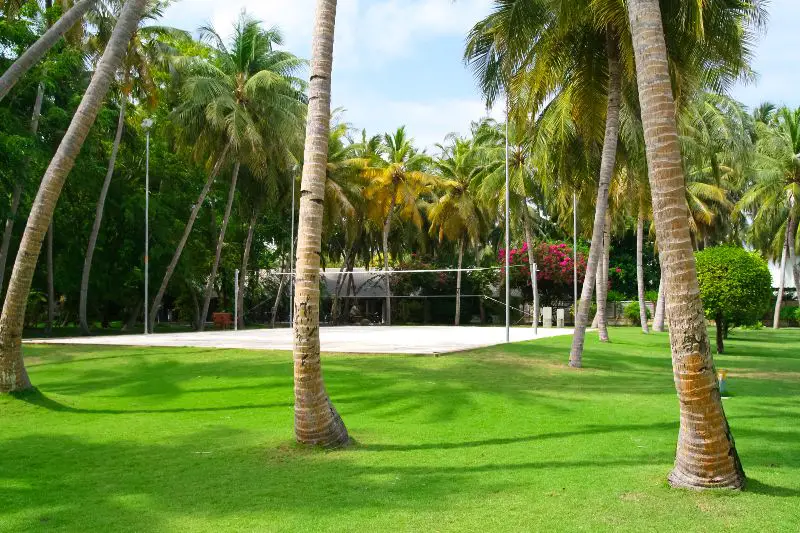
Many people with a backyard are not aware that they can have a lot of fun building a sand volleyball court in their yard and enjoy this activity with their family & friends…
Even those who want to do so are a little afraid and reluctant. They think it is going to be a mess!
In fact, building a sand court is really feasible as far as you are educated about the steps you should follow.
In this article, I breakdown all what you need to have and the steps you should follow to make sure your home volleyball court project will be a success.
What you will need to build a beach volleyball court?
A sand volleyball court can be set up in any place that is free of low-hanging tree branches or cables.
While the fundamental setup is easy, constructing your own volleyball court takes some time to prepare the ground and verify that all of the court’s components are installed safely.
First of all, you need to make sure the sand you are going to use is of a good quality. Otherwise, playing there won’t be as safe and as convenient as it should be.
Now, to hold up your Net you will need to use quality poles (I always recommend stainless steel poles, especially if you are close to the coast). Poles made of Anodized aluminum or even treated wood could be considered!
Quick Tip: If you don’t want to use poles and keep it light you can consider using a portable Net. For example, this quality portable Net is lightweight and could be removed and stored easily.
If you decide to stick to the poles, then make sure to prepare a proper concrete footing anywhere between 2 to 4 feet of depth. This will allow you to have poles up to 16 feet long if you want.
Finally, while outdoor volleyball nets are usually 39 inches tall, you can of course play with the size depending on your preferences.
How much it will cost you?
That’s probably the most important question, right?! Well, this varies a lot depending on so many factors …
Indeed, based on the design and size of your yard and family size, the cost to build a volleyball court is between $9,000-$20,000.
The following 3 areas will determine how much your basic costs will be:
- Sand and gravel
- Excavation equipment rental
- Court equipment.
If you reside near a beach, sand will most likely be readily available at a reasonable price. You’ll need to buy sand from a local sand pit or milling company unless you want to spend a lot of time at the beach with a shovel and a pickup truck.
If possible, use washed plaster sand, washed masonry sand, washed river sand, or washed beach or dune sand.
You can decide what type of volleyball court you would like, such as wood, metal, or vinyl.
The sand itself costs about $2,400 and the transport costs about $2,000.
$1,000 rentals, manpower, net, lines, equipment.
The price of the net, for example, can cost from $75 to $550.
It all depends on how much you are willing to spend on building and how much space you have.
I highly invite you to learn more about beach volleyball court costs …
Step – by – Step process to build a beach volleyball court in the backyard
Step 1. Playing area
After selecting a location that supports the size of the court that you want, it is typically suggested that the court orientation be set so that the net runs east to west.
This will prevent the sun from shining directly in the eye of the players in the morning and evening.
You should also consider how neighboring structures and shadows affect the game. You had to think about wind, sand erosion, the sun, and shadows, and how these might affect you.
Brightly colored tape or rope with similar properties should be used to create the boundary lines. Because ropes can cause burns if you come into contact with them by accident, sturdy 2″ wide webbing is suggested and used by professionals. We recommend removing the lines at night for safety concerns to prevent individuals from tripping and harming themselves.
The net’s plane serves as the court’s invisible center line, separating it into two halves.
Step 2. Draining
Drainage of the court beneath the sand must be considered, and this can be accomplished by correctly grading the land and placing a range-enhancing surface below the sand.
To allow for the construction of a drainage pipe on the regular slant, the court should be excavated an additional 30cm (below the sand depth of 30cm to 40cm) (14 degrees).
At the lowest point, the drainage point should lead away from the court.
Be aware of the natural surrounding slope so that you do not trap water with your inclined viewing sides. You may get away without the drainage system if you have sufficient drainage and no rocks, but we still recommend using the semi-permeable sand/soil.
Step 3. Sand
When you build a beach volleyball court with bad sand, you’re more likely to have a court that isn’t that usable.
Most new and experienced volleyball players dislike playing beach volleyball in a cloud of dust or in sand that tears up their knees and elbows.
As a result, sand selection is likely the most essential component in court design, and any sand used should be light-colored sands because they absorb the least amount of heat.
Quick Tip: You may want to test the sand before you make any purchases. You can check how the sand feels. Whether or not it will cut you by kneeling in the sand. It would be best if you did this in both dry and wet conditions. Make sure it is not agitating, nor does it cut you.
Step 4. Pole set-up
Again, if you decide to go heavy and use proper poles to hold your Net, then the recommendation is to opt for stainless steel. This will help you avoid their erosion!
This material also help support the tension so it won’t break even under significant pressure!
Although the poles do not need to be cemented in place, they should be. In most cases, both poles should be cemented in place and free of any hazardous protrusions.
If you use wood poles, it is recommended to not use concrete, because they will eventually break and it will be very difficult to remove the concrete and install the new pole. If you like, you can wrap padding around the poles to help protect the players on your court.
Step 5. Fil it in
Spread about 4″ to 6″ of small drainage gravel uniformly around the base of the court and drainage pipe once the poles are in place.
Then, to block the gravel from mixing with the sand while still allowing water to travel through to the drainage system, cover this layer with landscape fabric.
After that, cover your gravel with at least 1′ to 2′ of sand and spread it uniformly throughout the court with a shovel and a rake.
Step 6. Set a Net and place boundary markers
Installing the equipment is the final step in constructing a sand volleyball court.
To avoid harm, boundary marks should be on a different color from the used sand. You can use black or purple or any similar color. Obviously, you should avoid colors like yellow or orange.
How deep is a sand volleyball court?
Usually, the depth of a sand volleyball court is 2 and 3ft, because of the court light pole. They are placed at 3 feet deep if draining is not ideal.
Otherwise, with compact soil, a depth of 2 feet should be enough. Also, we can insert 5 feet into the sand of the overall light pole height is just 10 feet.
Or, we could go for a series of layers to allocate the light pole base for a more stable footing. Wind resistance bending, and tilting might be issues too.
In detail, the concrete footing must be installed as deep as necessary. Mainly to avoid any stability issues. Since the lay of the land can be extremely varied, the foundations of the building could affect the depth.
What kind of sand is used in volleyball court?
If you set foot in a pro beach volleyball league pitch, you will notice that sand is high – quality.
Usually, first – class volleyball sand comes from deep inside the mountains. Тhe seller sources and screens the raw products for rock flakes or pebbles. In fact impurities can cut the volleyball player’s skin.
Often, high quality sand is made, rounded, and polished from freshwater rivers. But in some locations, natural beach sand works just fine.
When choosing sand for a sand volleyball court, it’s best to go with washed masonry sand or sand that isn’t from a crushed-rock source.
When you’re looking for sand, try to select the cleanest feasible because sand that contains a lot of dirt can eventually condense into mud when wet.
Keep in mind that cleaning sand court is important to make it sustainable! You can have a look at these tips to properly clean sand volleyball court ….
Final Thoughts…
Hopefully, the amount of information I’ve shared in this article is not too overwhelming for you. I invite you to read this article more than once to make sure you fully understand the steps you need to follow.
Finally, I highly encourage you to check this guide on how to become a beach volleyball player …
